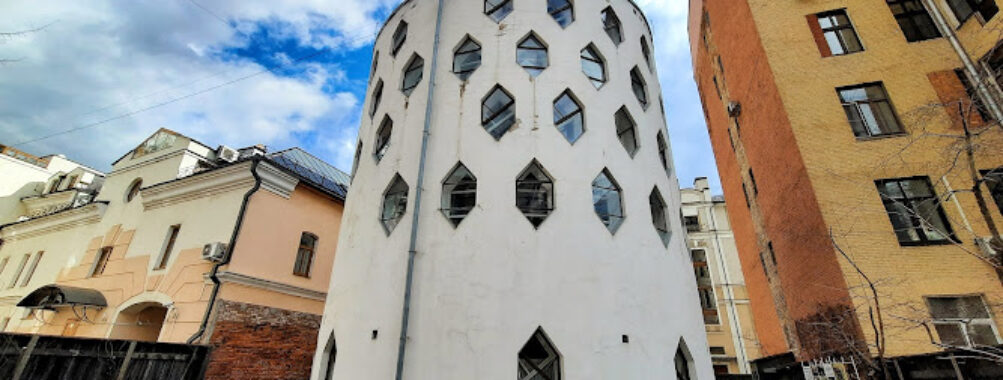
State Museum of Konstantin and Viktor Melnikov
Table of Contents
Description
The State Museum of Konstantin and Viktor Melnikov in Moscow is not your average museum—it’s a living piece of avant-garde architecture that feels more like stepping into someone’s eccentric dream than wandering through a curated gallery. Built in the late 1920s by Konstantin Melnikov as his own home and studio, the building itself is the main exhibit. Imagine a cylindrical structure punctured with honeycomb-shaped windows, almost like a giant lantern glowing in the middle of the city. It’s both strange and beautiful, and honestly, it’s one of those places that makes you stop and think, “Wow, people were this bold nearly a century ago?”
The museum doesn’t just showcase architectural drawings or dusty models—it’s the actual house where Konstantin lived and worked, later preserved by his son Viktor. Walking inside, you’ll find yourself surrounded by quirky angles, unexpected curves, and a sense of intimacy that most museums simply don’t have. It’s small, yes, but that’s part of its charm. If you’re the kind of traveler who prefers hidden gems over blockbuster attractions, this place will speak to you. And while some visitors might feel it’s a bit too niche or minimalist, others leave completely inspired by the creativity and vision that shaped modern architecture.
Personally, I found the space to be a refreshing break from Moscow’s grand, imposing landmarks. It’s like slipping into a side story of the city—a quieter, more personal narrative about art, resilience, and imagination. Sure, it’s not flashy, and you won’t find a café or gift shop waiting for you at the end, but that’s exactly what makes it feel authentic. It’s a museum that asks you to slow down, to notice the details, and to appreciate the life and work of two men who dared to think differently.
Key Features
- Unique cylindrical house designed by Konstantin Melnikov in the 1920s
- Distinctive honeycomb-style windows that flood the interior with light
- Personal belongings and studio spaces preserved from the Melnikov family
- Intimate, small-scale museum experience with guided tours available
- Focus on avant-garde architecture and Soviet-era design experiments
- Family-friendly atmosphere, though with limited amenities
Best Time to Visit
If you’re planning a trip, aim for late spring through early autumn. Moscow’s winters can be brutal, and while the house itself is indoors, the experience of getting there is far more pleasant when the streets aren’t icy and the air doesn’t sting your face. I visited in May, and the walk to the museum was lined with blooming trees and locals enjoying the sunshine—it set the perfect mood. That said, if you’re someone who loves the moody, atmospheric vibe of winter travel, the starkness of the city around the house in January or February could add another layer of intrigue. Just bundle up.
Weekdays are generally quieter, so if you want to avoid crowds and really soak in the atmosphere, that’s your best bet. Weekends can feel a touch cramped inside given how compact the house is, and you’ll want space to move around and actually see the details without bumping elbows.
How to Get There
The museum is located in central Moscow, within easy reach of the city’s metro system. The metro is hands down the most efficient way to get around—you’ll save yourself a lot of time and stress compared to navigating traffic. From the nearest metro stop, it’s a short walk through residential streets, which honestly adds to the experience. There’s something poetic about approaching this architectural oddity through the everyday rhythm of Moscow life.
Taxis and ride-hailing apps are also an option if you prefer door-to-door convenience, though be prepared for traffic if you’re traveling during rush hour. Parking in the area can be tricky, and the museum doesn’t have its own lot, so I wouldn’t recommend driving unless absolutely necessary.
Tips for Visiting
First things first: book a guided tour if you can. The house is fascinating on its own, but having someone explain the design choices, the historical context, and even the little quirks of the Melnikov family makes the visit so much richer. Without that, you might walk through and think, “Well, that was unusual,” and miss out on the deeper story.
Second, don’t expect modern amenities. There’s no café, no restaurant, and restrooms are very limited. Grab a coffee before you head in and plan accordingly. And if you’re traveling with someone who uses a wheelchair or stroller, be aware that accessibility is limited—the house was built in the 1920s with no thought for ramps or lifts.
Bring your curiosity and your patience. This isn’t a place to rush through. Take time to notice the way the light filters through the hexagonal windows, or how the spiral staircase makes you feel slightly off balance. If you’re into photography, you’ll find plenty of angles and textures worth capturing, though remember that rules about photography can vary, so check ahead.
And one last personal tip: pair your visit with a stroll through Moscow’s nearby neighborhoods. After immersing yourself in the avant-garde world of Melnikov, stepping back into the bustling city feels like a contrast that deepens the whole experience. It’s a reminder that travel isn’t just about ticking off landmarks—it’s about the stories you collect along the way.
Location
Places to Stay Near State Museum of Konstantin and Viktor Melnikov
Find and Book a Tour
Explore More Travel Guides
No reviews found! Be the first to review!